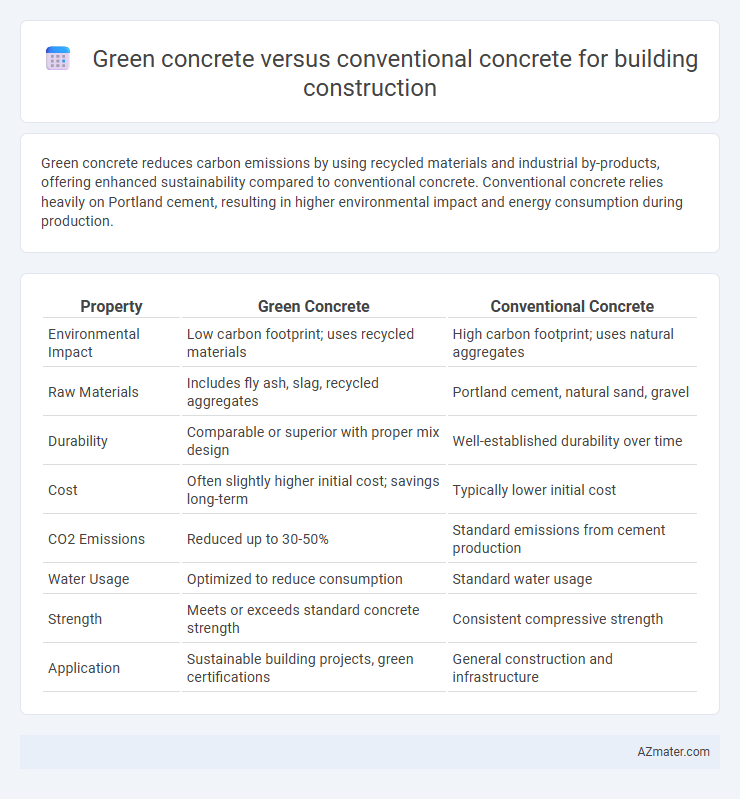Green concrete reduces carbon emissions by using recycled materials and industrial by-products, offering enhanced sustainability compared to conventional concrete. Conventional concrete relies heavily on Portland cement, resulting in higher environmental impact and energy consumption during production.
Table of Comparison
| Property | Green Concrete | Conventional Concrete |
|---|---|---|
| Environmental Impact | Low carbon footprint; uses recycled materials | High carbon footprint; uses natural aggregates |
| Raw Materials | Includes fly ash, slag, recycled aggregates | Portland cement, natural sand, gravel |
| Durability | Comparable or superior with proper mix design | Well-established durability over time |
| Cost | Often slightly higher initial cost; savings long-term | Typically lower initial cost |
| CO2 Emissions | Reduced up to 30-50% | Standard emissions from cement production |
| Water Usage | Optimized to reduce consumption | Standard water usage |
| Strength | Meets or exceeds standard concrete strength | Consistent compressive strength |
| Application | Sustainable building projects, green certifications | General construction and infrastructure |
Introduction to Green Concrete and Conventional Concrete
Green concrete incorporates industrial waste materials and recycled components, reducing carbon footprint and conserving natural resources, while maintaining comparable strength and durability to conventional concrete. Conventional concrete primarily uses Portland cement, aggregates, and water, producing significant CO2 emissions during cement production and leading to environmental concerns. The shift towards green concrete addresses sustainability challenges in building construction by lowering greenhouse gas emissions and enhancing resource efficiency.
Key Components of Green Concrete
Green concrete incorporates industrial byproducts such as fly ash, slag cement, and silica fume as partial replacements for traditional Portland cement, reducing carbon emissions and enhancing durability. The use of recycled aggregates and water-efficient admixtures further minimizes environmental impact while maintaining structural integrity. These key components contribute to energy savings, lower greenhouse gas emissions, and improved sustainability compared to conventional concrete in building construction.
Traditional Ingredients in Conventional Concrete
Conventional concrete primarily consists of traditional ingredients such as Portland cement, water, fine aggregates (sand), and coarse aggregates (gravel or crushed stone), which provide the essential strength and durability for building construction. Portland cement, derived from limestone and clay, acts as the key binder that hydrates to form a rigid matrix, while aggregates occupy most of the volume, contributing to compressive strength and reducing shrinkage. This reliance on non-renewable raw materials and energy-intensive cement production is a major environmental concern compared to green concrete alternatives.
Environmental Impact Assessment
Green concrete significantly reduces carbon emissions by incorporating recycled materials such as fly ash, slag, and silica fume, which lower the reliance on Portland cement, a major greenhouse gas contributor. Life cycle assessments indicate that green concrete decreases energy consumption and reduces natural resource depletion compared to conventional concrete. These environmental benefits contribute to sustainable building practices by minimizing the overall ecological footprint throughout production and construction phases.
Strength and Durability Comparison
Green concrete incorporates recycled materials and industrial by-products, enhancing its compressive strength and reducing environmental impact compared to conventional concrete. Studies show green concrete can achieve comparable or superior durability, with improved resistance to chemical attacks and reduced permeability. This makes green concrete a sustainable choice for long-lasting structures without compromising structural integrity.
Cost Analysis: Initial and Lifecycle Expenses
Green concrete typically incurs higher initial costs due to the use of recycled materials and innovative additives, but these expenses are offset by lower lifecycle costs stemming from enhanced durability, reduced maintenance, and improved thermal efficiency. Conventional concrete often has lower upfront costs but may lead to increased long-term expenses due to frequent repairs and higher energy consumption. Lifecycle cost analysis reveals green concrete as a more economically sustainable option for building construction when considering total cost of ownership over time.
Workability and Performance Differences
Green concrete incorporates industrial byproducts like fly ash and slag, enhancing workability by reducing water demand and improving flow properties compared to conventional concrete. Its performance excels in durability and sustainability, exhibiting lower carbon emissions and increased resistance to chemical attacks, whereas conventional concrete often shows higher shrinkage and susceptibility to cracking. The optimized mix design of green concrete ensures comparable or superior compressive strength while promoting eco-friendly construction practices.
Sustainability and Energy Efficiency
Green concrete significantly reduces environmental impact by incorporating industrial waste materials like fly ash and slag, decreasing carbon emissions compared to conventional concrete. Its enhanced thermal insulation properties contribute to improved energy efficiency in buildings, lowering heating and cooling demands. The use of recycled materials and reduced resource extraction makes green concrete a sustainable alternative in modern construction projects.
Challenges and Limitations of Green Concrete
Green concrete faces challenges such as lower early strength and slower curing times compared to conventional concrete, which can delay construction schedules. The availability and consistency of sustainable raw materials like industrial by-products or recycled aggregates remain limited, impacting large-scale adoption. Cost considerations and lack of standardized mix designs further restrict the widespread use of green concrete in building construction.
Future Trends in Sustainable Building Materials
Green concrete, incorporating recycled materials and industrial by-products like fly ash and slag, significantly reduces carbon emissions compared to conventional concrete, which relies heavily on Portland cement production. Future trends in sustainable building materials emphasize enhanced durability, carbon capture technology, and increased use of bio-based additives in green concrete to improve environmental performance and reduce lifecycle impacts. Innovations such as nanomaterials and 3D printing integration are expected to drive the adoption of green concrete in eco-friendly building construction, promoting a circular economy and resilience in urban infrastructure.

Infographic: Green concrete vs Conventional concrete for Building construction
 azmater.com
azmater.com